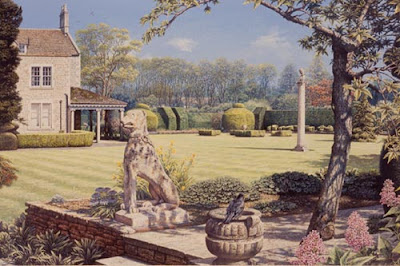1.
Which was the first Fighting Fantasy gamebook you read?
This was Deathtrap Dungeon,
illustrated by Ian McCaig – it was sent to me when I started my first FF cover Masks of Mayhem. I loved the
illustrations and the set pieces in the story. I decided then that I would take
on interior drawings for future titles if asked.
2.
Did you read FF before illustrating it?
I knew of the series before illustrating them but had never read
them as a punter.
3.
Which is your favourite gamebook?
I don't have a favourite gamebook – I respond to the imagery and
drama – the more visual elements. That was the thing with McCaig’s work – loads
of movement and eerie stuff going on, and he could frame each scene like a
scene in a movie.
4.
How did you find the process of illustrating FF books? Was it an enjoyable
experience? How did it compare to other illustration jobs? How did your work on Dungeoneer and the covers for the AFF
series compare to illustrating a normal gamebook like Midnight Rogue?
I found it quite easy to create a style for the interior drawings
– more than I expected really – and enjoyed the process of creating on-going
characters for Dungeoneer*. I had to
design their armour/clothes and general 'look' in a 360 degree viewpoint –
including above and below. Some worked
better than others. Midnight Rogue had a different approach. The reader became
the thief character and their/your hands were seen manipulating locks and
purses. I enjoyed doing this story as
they were claustrophobic – more shadowy and closed in. I felt I inhabited this
world while drawing them.
Each of the three book
interiors were luckily completely different in tone, and although it
could be pretty relentless churning out the drawings – and I had no time for
any 'rough' sketches – now and again I look at the originals and am amazed at
the work and detail involved.
5.
What are working on now?
I spend a lot of time reconstructing fossil creatures and
environments – dinosaur, pterosaurs, and human evolution – for museums, books
and now and again TV. This year I have mostly commissioned paintings, after
doing a lot of book illustration last year. I do the occasional fantasy project
but there is not much of that out there for me at the moment.
6.
How much did FF influence your career and what you are doing today?
FF gave me the opportunity to design a lot of scenarios in each
book – you have to be consistent and able to dramatise the subjects listed –
over 30 or so in each book plus vignetted text fillers. It gave me the confidence
to do this, working fast, sometimes having to produce a drawing a day. I worked
for Games Workshop at roughly the same time, and so the FF work helped me there
– working on their larger book formats and model characters.
7.
What is it that makes FF so special?
I think it is the parallel storylines, scary characters and
situations, which is great for encouraging young kids in their reading and
competing with friends at the same time. The multiple options and fantastic
imagery makes them an original, affordable and quality product. (Sorry, sounds
like an ad!)
8.
How do you explain the gamebook resurgence of the last couple of years?
There is a lot of looking back in publishing and the generation
that first read FF are very big on re-visiting their youth! The effort and quality put into gamebooks has
not dated at all and movies have been influenced by them, especially Harry
Potter, with scenes of varying danger and monsters cropping up every other
scene!
9.
What do you feel was the impact of video games on FF (both negative and
positive)?
I'm not a fan of video games – I prefer print, but I can see that
the FF imagery involves the viewer and the drama is directed at them in the
same way as that on screen. The whole
point is making decisions to avoid death (or worse) and can be re-run over and
over to change the outcome. The
difference with FF is the chance outcome with dice instead of skill at the
controls.
10.
Where is there left for gamebooks/FF to go?
Who knows? The original books are mainly small, with mono interiors
to keep down the price. Maybe electronic books, or larger full-colour formats;
3D would take them onto another level.
11. Do
you think people will still be talking about FF in another 30 years?
Of course – the concept is universal – safely going into places of
danger and with the competitive drama element it cannot fail whatever the
medium they are in.
Thanks again to John for taking time out of his schedule to answer my questions. You can find a lot of his work (especially his dinosaur paintings) here at his website.
And remember to check back again tomorrow to see who I'll be interviewing for the letter 'Y'.
* You might be interested to know that it was John's cover painting of Dungeoneer that was the original inspiration behind my first Fighting Fantasy adventure (and consequently my very first published book) Spellbreaker.



















No comments:
Post a Comment